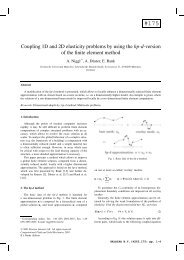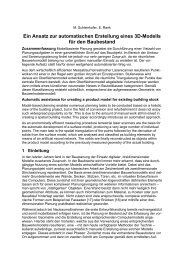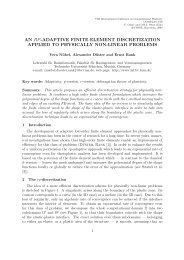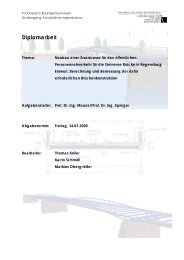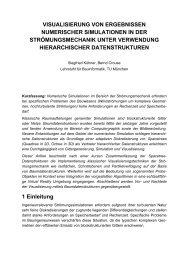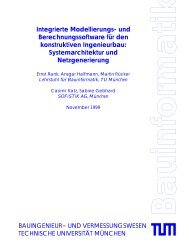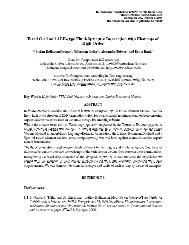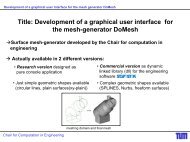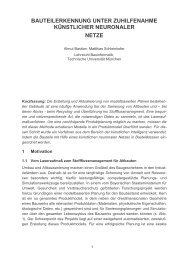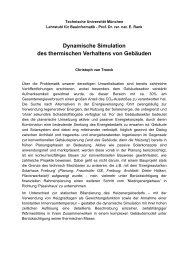Computational engineering for wind-exposed thin-walled structures
Computational engineering for wind-exposed thin-walled structures
Computational engineering for wind-exposed thin-walled structures
Create successful ePaper yourself
Turn your PDF publications into a flip-book with our unique Google optimized e-Paper software.
2 Ansgar Halfmann et al.<br />
large umbrellas (Fig. 1 [10]), the most demanding <strong>engineering</strong> task is to<br />
dimension the construction so that it will resist <strong>wind</strong> loads. Following the<br />
Davenport-Wind-Load-Chain an assumed local <strong>wind</strong> prole <strong>for</strong> a given terrain<br />
can be established according to the European Design Code EC 1 [5].<br />
This <strong>wind</strong> distribution causes a pressure eld on the structure. If simplied,<br />
conventional load assumptions <strong>for</strong> this pressure distribution are made, the<br />
<strong>structures</strong> may be strongly over-designed. Yet, also an under-design with the<br />
danger of a collapse may result from this simplied procedure, as the mutual<br />
inuence of neighbouring constructions could change the <strong>wind</strong> pressure eld<br />
dramatically. There<strong>for</strong>e, todays standard of practice are time-consuming and<br />
costly experiments in <strong>wind</strong> tunnels. A model of the construction is considered<br />
and <strong>wind</strong> pressure elds on its surface are measured to be used <strong>for</strong> later<br />
numerical structural analysis. One of the major drawbacks of this mixed computational<br />
and experimental approach is the diculty toquickly change the<br />
geometry of the model construction <strong>for</strong> the <strong>wind</strong> tunnel experiment. There<strong>for</strong>e,<br />
it would be highly desirable to have a'numerical <strong>wind</strong> tunnel' available,<br />
being directly integrated in the civil <strong>engineering</strong> design and analysis process,<br />
and enabling to investigate a structure also under the inuence of neighbouring<br />
constructions. Several steps in this direction have been per<strong>for</strong>med by the<br />
authors in a joint research project during the past two years and will be<br />
presented in this contribution.<br />
2 Software architecture<br />
The software architecture shown in Fig. 2 is inuenced by the idea of a loose<br />
coupling strategy based on highly specialized and well evaluated simulation<br />
codes, each developed <strong>for</strong> the special eld of the interacting system. In a<br />
rst step, the structural model is dened, using a classical CAD environment<br />
onaPCoraworkstation. Toconsider<br />
dierent stress distributions<br />
in a membrane, it is possible to<br />
compute the geometric shape of<br />
pure membrane <strong>structures</strong> in a<br />
<strong>for</strong>mnding process [2]. Thereby<br />
the de<strong>for</strong>med shape of the structure<br />
under dead load is computed<br />
by a nite element analysis starting<br />
from an inital geometry. Using<br />
special membrane elements<br />
and assuming an initial stiness<br />
caused by isotropic prestressing<br />
PC / workstation<br />
supercomputer<br />
STL-file<br />
ICEM-CFD<br />
fluid-simulation<br />
FASTEST-3D<br />
Geometrical Model<br />
+boundary conditions<br />
AutoCAD / SOFiPLUS<br />
<strong>for</strong>mfinding process<br />
MpCCI<br />
SOFiMESH<br />
DO_MESH<br />
structure-simulation<br />
ASE<br />
creates<br />
PC / workstation TECPLOT / Explorer Wingraf / Animator<br />
CDBASE<br />
Fig. 2. Software structure<br />
and neglecting any bending stiness, the de<strong>for</strong>med shape will lead to the<br />
soap lm <strong>for</strong>m with its constant isotropic stress distribution. All geometric<br />
in<strong>for</strong>mation is stored in a database describing a b-rep (boundary repre-



